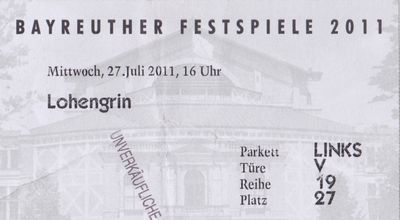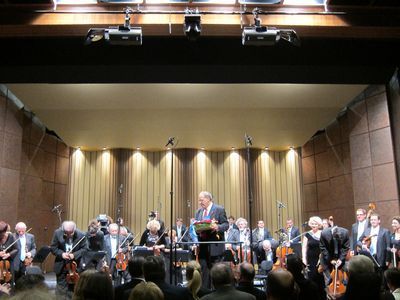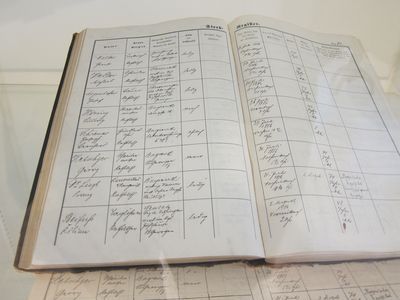Alex Ross's Blog, page 222
August 12, 2011
Video of the day
The late, great Johnny Carson attempts to play the theremin on The Johnny Carson Show, which ran from 1955 to 1956. Samuel Hoffman, who played theremin in Spellbound and The Day the Earth Stood Still, is Carson's guide. These were different days in American pop culture: a Margaret Truman joke is followed by a Helen Traubel joke. The young Johnny is a little bit campier than the later one. (Via Jon Bernhardt.)
August 11, 2011
The Gershwin Estate's Porgy and Bess
 Stephen Sondheim has written a scouringly funny response to a recent New York Times piece on Diana Paulus's new production of Porgy and Bess — or The Gershwins' Porgy and Bess, as the opera has been retitled. Whether or not you agree with Mr. Sondheim's views, you have to admire the manner of their expression. If I were Paulus, I would consider booking a trip to Antarctica in an effort to get away from the single sentence "Wow, who'd have thought there was a love story hiding in Porgy and Bess that just needed a group of visionaries to bring it out?"
Stephen Sondheim has written a scouringly funny response to a recent New York Times piece on Diana Paulus's new production of Porgy and Bess — or The Gershwins' Porgy and Bess, as the opera has been retitled. Whether or not you agree with Mr. Sondheim's views, you have to admire the manner of their expression. If I were Paulus, I would consider booking a trip to Antarctica in an effort to get away from the single sentence "Wow, who'd have thought there was a love story hiding in Porgy and Bess that just needed a group of visionaries to bring it out?"
Worth noting is a comment from Joshua Cohen: "Why are we even talking about this? That is, why can't anybody do anything with Porgy and Bess that they please? Why does current American law keep a work more than 75 years old, whose last creator died more than 25 years ago, under copyright?" This is indeed the underlying issue. If Porgy and Bess were in the public domain, we'd have revisionist productions all over the place, and dunderheaded schemes for it would quickly come and go. But the Gershwin estate exercises a powerful hold over all uses of the composer's work. And, as this Copyright Primer helpfully explains (see Scenario 9), the joint action of the Copyright Act of 1976 and the Copyright Term Extension Act of 1998 means that Porgy will pass into the public domain only in 2030. People often blame the Walt Disney Company for these ludicrous extensions of copyright terms, but the Gershwin estate has also played an active role; in both cases, the expiration of the Rhapsody in Blue copyright was looming, first in 1980 and then in 2000. The families' cash cow has remained sacred.
August 10, 2011
Miscellany: Concert dress, etc.
There's an interesting debate going on among Mark Swed, Amanda Ameer, and Anne Midgette over Yuja Wang's fashion choices at recent recitals. I'd side with Anne here. For too long classical performers have been costumed essentially as high-end hired help; let them dress as they wish.... Anna Lundh goes in search of the lost computer opera of Karl-Birger Blomdahl.... Daniel Felsenfeld and Eleonor Sandresky are raising money for a marathon concert, entitled Music After, dedicated to composers who were living in downtown Manhattan on September 11th. They write, "The day will be about Music — speech-making and memorializing will happen elsewhere and by others." The program will include works of Philip Glass, Julia Wolfe, David Del Tredici, Laurie Anderson, Rosanne Cash, David Lang, Meredith Monk, Judd Greenstein, Michael Gordon, Sarah Kirkland Snider, Sxip Shirey, Elliott Carter, and Steve Reich, as well as music by the presenters.... The gifted young composer Anthony Cheung has a fascinating essay on his influences in the new issue of Esopus magazine; there's an accompanying CD.... Red Light New Music has announced an enticing 2011-12 season.... Composer Nat Evans hosts his site-specific work Assemblage at Brooklyn Bridge Park on August 21, just before sunset. You download the piece in advance and press play at the appointed time.... Site-specific on a grander scale: in October the musical Biennale of Venice will present Ritual Rowing, a series of performances on and around the cemetery island of San Michele.
August 9, 2011
Verses of the day
Now days are dragon-ridden, the nightmare
Rides upon sleep: a drunken soldiery
Can leave the mother, murdered at her door,
To crawl in her own blood, and go scot-free;
The night can sweat with terror as before
We pieced our thoughts into philosophy,
And planned to bring the world under a rule,
Who are but weasels fighting in a hole.
— Yeats, "Nineteen Hundred and Nineteen"
Third Bayreuth pilgrimage
The last time I visited Bayreuth, in 2004, I provided a series of photojournals. This time I will bother you with but one omnibus post of miscellaneous snapshots. My full review appears in this week's New Yorker; my 2004 column can be found here, and my report on Jürgen Flimm's 2000 production of the Ring is in the New Yorker archive.
Every year or two I save a ticket from a performance that has made a particularly deep impression on me. The Hans Neuenfels Lohengrin, with Andris Nelsons conducting and Klaus Florian Vogt in the lead, was one such. The last time I did this was for Chéreau's From the House of the Dead at the Met.
I never cease to be astounded that a modern head of state takes a serious interest in Wagner — or any classical composer, for that matter. For anyone who missed it, here is my video of Angela Merkel at the second Tannhäuser intermission:
More of the red-carpet ritual, with Horst Seehofer, Minister-President of Bavaria, glad-handing the crowd:
This was the one hundredth edition of the Bayreuth festival (it became an annual affair only in the thirties), and one enthusiast commemorated the occasion by donning a hat emblazoned with the number "100" and Wagner's picture:
Fashion points also go to this ensemble:
The amazing Spider-Man and the amazing Lohengrin:
When the lights went down, the hard work began — trying to decipher Sebastian Baumgarten's conception of Tannhäuser. A chart supplied by the press office did not entirely clarify matters:
A major event during the opening festival week was a performance by the Israel Chamber Orchestra at Bayreuth Town Hall. The program consisted of Mahler's Rückert Lieder (with Dietrich Henschel), Mendelssohn's "Italian" Symphony, Prayer by the Israeli composer Tzvi Avni, Liszt's Angelus!, and Wagner's Siegfried-Idyll. To hear Israeli musicians playing Wagner in Bayreuth was something of an event, even if there was nothing remarkable about the performance itself. Katharina Wagner, the composer's great-granddaughter and the co-director of the festival, was in attendance, her blonde ponytail visible in the bottom center of this picture:
The music of Liszt is much in evidence in Bayreuth this summer, the composer having died in the town in 1886. (I wrote about Liszt's final years in 2003.) A series of concerts and exhibitions has been gathered under the title Lust auf Liszt:
The death registry recording Liszt's passing (left-hand side, second from bottom), on display at Steingraeber & Söhne:
I paused before the great wall of Wagner books in the Markgrafen bookstore:
And subsisted largely on Festspiele bratwurst:
I hope to return for the new Ring — and the remodeled Wagner Museum at Wahnfried — in 2013.
Another Bayreuth pilgrimage
The last time I visited Bayreuth, in 2004, I provided a series of photojournals. This time I will bother you with but one omnibus post of miscellaneous snapshots. My full review appears in this week's New Yorker; my 2004 column can be found here, and my report on Jürgen Flimm's 2000 production of the Ring is in the New Yorker archive.
Every year or two I save a ticket from a performance that has made a particularly deep impression on me. The Hans Neuenfels Lohengrin, with Andris Nelsons conducting and Klaus Florian Vogt in the lead, was one such. The last time I did this was for Chéreau's From the House of the Dead at the Met.
I never cease to be astounded that a modern head of state takes a serious interest in Wagner. For anyone who missed it, here is my video of Angela Merkel at the second Tannhäuser intermission:
More of the red-carpet ritual, with Horst Seehofer, Minister-President of Bavaria, glad-handing the crowd:
This was the one hundredth edition of the Bayreuth festival (it became an annual affair only in the thirties), and one enthusiast commemorated the occasion by donning a hat emblazoned with the number "100" and Wagner's picture:
Fashion points also go to this ensemble:
The amazing Spider-Man and the amazing Lohengrin:
When the lights went down, the hard work began — trying to decipher Sebastian Baumgarten's conception of Tannhäuser. A chart supplied by the press office did not entirely clarify matters:
A major event during the opening festival week was a performance by the Israel Chamber Orchestra at Bayreuth Town Hall. The program consisted of Mahler's Rückert Lieder (with Dietrich Henschel), Mendelssohn's "Italian" Symphony, Prayer by the Israeli composer Tzvi Avni, Liszt's Angelus!, and Wagner's Siegfried-Idyll. To hear Israeli musicians playing Wagner in Bayreuth was something of an event, even if there was nothing remarkable about the performance itself. Katharina Wagner, the composer's great-granddaughter and the co-director of the festival, was in attendance, her blonde ponytail visible in the bottom center of this picture:
The music of Liszt is much in evidence in Bayreuth this summer, the composer having died in the town in 1886. (I wrote about Liszt's final years in 2003.) A series of concerts and exhibitions has been gathered under the title Lust auf Liszt:
The death registry recording Liszt's passing (left-hand side, second from bottom):
I paused before the great wall of Wagner books in the Markgrafen bookstore:
And subsisted largely on Festspiele bratwurst:
I hope to return for the new Ring — and the remodeled Wagner Museum at Wahnfried — in 2013.
August 8, 2011
Postcard from Rio
Bayreuth 2011
The Wagner Identity. The New Yorker, Aug. 15, 2011 (subscribers only).
August 6, 2011
Atalla Ayan
People here in Brazil are abuzz over the young tenor Atalla Ayan, who sings in Roméo et Juliette at the Theatro São Pedro in São Paulo next week. A few weeks ago Ayan sang in New York for the first time, at an outdoor Met recital, winning positive reviews from Allan Kozinn and James Jorden. The video above is from three years ago, when the tenor was only twenty-two or so; he obviously possesses extraordinary talent, and let's hope that he takes wise advice and develops in a sensible way. This fall he'll be singing Rodolfo in Glyndebourne on tour.
Ruders, Björk, Michael Jackson
 Last weekend, the Lincoln Center Festival presented Selma Jezková, Poul Ruders's operatic adaptation of the Lars von Trier film Dancer in the Dark. I concur with Zachary Woolfe in thinking that Ruders, in spite of his usual orchestral brilliance, didn't succeed in bringing this material to dramatic life, nor did he measure up to the suite of songs and instrumental music that Björk, the star of von Trier's film, created for the occasion. Notwithstanding her "pop" status, Björk has the stronger artistic personality, the more original musical mind. That she gave an extraordinary performance in the film is beside the point: the songs themselves have a powerful aura, simply as compositions.
Last weekend, the Lincoln Center Festival presented Selma Jezková, Poul Ruders's operatic adaptation of the Lars von Trier film Dancer in the Dark. I concur with Zachary Woolfe in thinking that Ruders, in spite of his usual orchestral brilliance, didn't succeed in bringing this material to dramatic life, nor did he measure up to the suite of songs and instrumental music that Björk, the star of von Trier's film, created for the occasion. Notwithstanding her "pop" status, Björk has the stronger artistic personality, the more original musical mind. That she gave an extraordinary performance in the film is beside the point: the songs themselves have a powerful aura, simply as compositions.
Revisting the topic of Dancer in the Dark reminded me of a conversation I'd had with Björk when I profiled her for The New Yorker in 2004. She strongly disliked working with von Trier, as she made very clear at the time. But what came to mind were some remarks she made on the topic of fame and originality. I had proposed to her that it takes a peculiar sort of person to appear "normal" in the lens of the modern media. Normality requires, in a way, a strenuous, round-the-clock performance. If you don't observe its conventions — if you act in a natural, impulsive, human way — you will be labeled "crazy." Björk didn't respond directly. Instead, she pointed to her computer, where, on the front page of a news site, the face of Michael Jackson appeared, and said the following:
OK, so he's not "normal." But these terms are beside the point with him. He's original. That's the real problem. Modern times has a fear of, a hatred of, the original. I read an interview with Rem Koolhaas which got me very riled up, in a way, because of what he said about originality. He said something about being a gatherer, going to India or someplace and coming back with a lot of ideas. He resents those who show up full of their own ideas. He uses this phrase, "tyranny of the oblivious." He feels oppressed by these oblivious people who are not part of the smart, sophisticated game where everything becomes a quotation from something else. Lars von Trier has the same problem, by the way. This is where the rage against Michael Jackson really comes from — the hatred of eccentricity. I don't think it's crazy that he should want to live like that — have a giraffe, redo his face — if that's what it means to be himself. He made his own world, and that was a threat. Now they are going to destroy it.
I included this passage in the original draft of the article, and then cut it, because it was something of a digression. Björk's most striking point, I think, is that creativity in its highest form does require a kind of obliviousness — and in the digital age the effort needed to tune out all those teeming echoes and quotations is practically heroic.
Alex Ross's Blog
- Alex Ross's profile
- 425 followers















